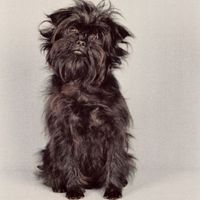
Boerboel / South African Boerboel, South African Mastiff

Breed history:
The origins of this breed are still uncertain and are lost in the mist of time. In the African language, "Boer" means farmer, and this dog is said to have been a farmer's dog. According to some sources this dog is from the time of Alexander the Great, when such strong and big dogs were used for hunting and fighting with other animals. Other sources place the origins of this breed later, when Jan van Riebeek arrived in Cape in 1652; he brought with him some massive dogs like the Mastiff type dog. Later, the European settlers also brought such dogs, which crossbread with local dogs gave birth to today's Boerboel. In 1830 these dogs were more like hounds, because they accompanied the European settlers in the Great Journey on a distance of more than 1400 km (879 miles) from Cape to Gauteg. Today's Boerboel has kept most its physical features, but now it's a family dog, with a gentle and protective behaviour, not a hunting or a fighting dog.
Description:
It is a large-sized dog, massive, robust, well-built, with a strong, brawny and graceful body. The head is short, wide, deep, square and brawny. It has a moderate stop and a black muzzle with large and widely-spaced nostrils. The jaws are strong, deep with white, well-developed teeth; it has a scissor type bite. The eyes are dark, generally dark brown but never blue. The ears are V-shaped, medium-sized and drooping. The body is sturdy, strong and stout with a deep chest. The nose, eyelids, lips, eyes, paws and claws are strongly pigmented; the skin is also black. The legs are strong, sturdy and brawny. The tail is thick, strong, with a pointy tip and can be docked. The fur is short, smooth, glossy and could be beige, reddish brown, brown, coffee-coloured, dark brown or striped. It has a black-masked muzzle, mask that can sometimes reach the eyes.
Personality:
It's a careful, quiet, playful, brave, very intelligent, well-balanced and very sensitive dog, which adapts easily and is a fast learner. It loves its master and family very much. It is loyal and can tolerate even children's rougher games. If it is not trained for fighting it is a very peaceful, quiet, tolerant, loving and not at all aggressive dog. But if it is trained for fighting, then it becomes a beast, a very dangerous, strong and aggressive enemy. An ancient story about this dog is well known among the breed's specialists:
"The Albanian King, in his wish to show his consideration towards the Macedonian King - Alexander the Great at that time, presents him with a large dog, impressive in aspect and build. He is very happy about the gift but becomes disappointed when he notices that this huge animal will not fight a bear, a boar and a stag. Considering it useless, the Macedonian King orders it to be killed. The news makes the Albanian King sad because the dog he sent was just a companion dog. So he sends a second dog to Alexander the Great, almost identical with the first. Alexander throws this dog in a fight with a lion and then with an elephant. The king becomes pleasantly surprised and amazed at its ferocity, agility and courage in fighting wild animals."
Grooming:
It doesn't need too much grooming. An occasional brushing and a bath once a month is enough. It has a medium level of hair shedding.
Living conditions:
It is a large dog, resistant to weather changes, that's why it needs space for exercise. It can adapt to a flat if walked daily in order to exercise. It needs socializing, training and a lot of exercise from an early age. A bored Boerboel becomes destructive and can cause serious damage. It likes to take long walks, to run, to play with a ball. It is recommended that the master should have experience in breeding dogs and be able to assert his dominance; it's that kind of dog that must know the pack hierarchy, and the leader of the pack must be the master. From an early age it should be placed in new situations, so it can meet new people.
Training:
This is not a difficult dog to train, but however, it is recommended that the training should be done by an experienced person. It needs a gentle, well-balanced, consistent and pacient training. A training based on submission and obedience is recommended. It must not be trained for fighting. It behaves well in agility, flyball and fetch contests.
Usefulness:
It is an excellent, very protective watchdog. If not trained for fighting at all it can also be an excellent companion.


Austrian Shorthaired Pinscher
Austrian Pinscher, Osterreichischer Kurzhaarpinscher, Österreichischer, Österreichischer Pinscher




